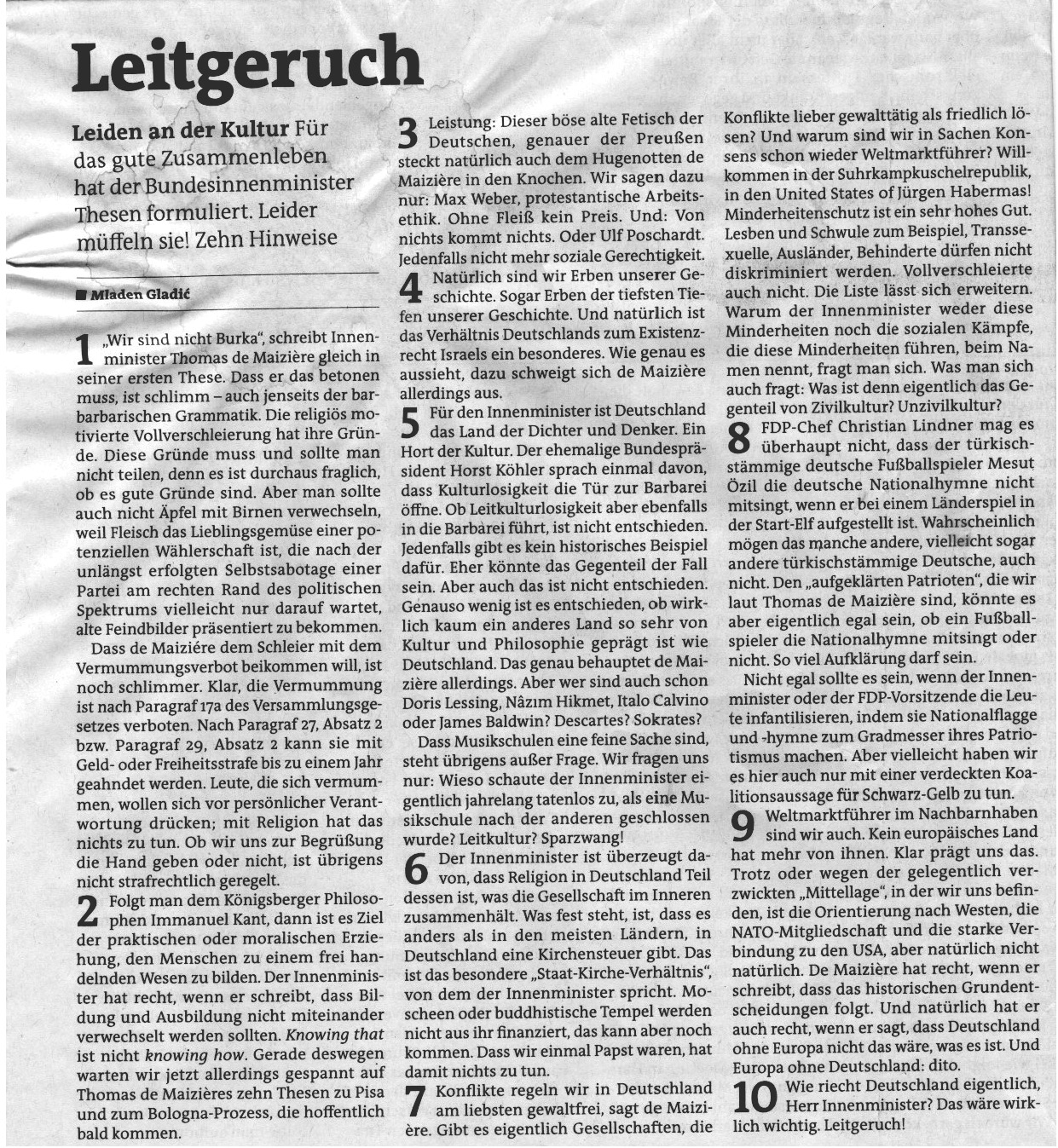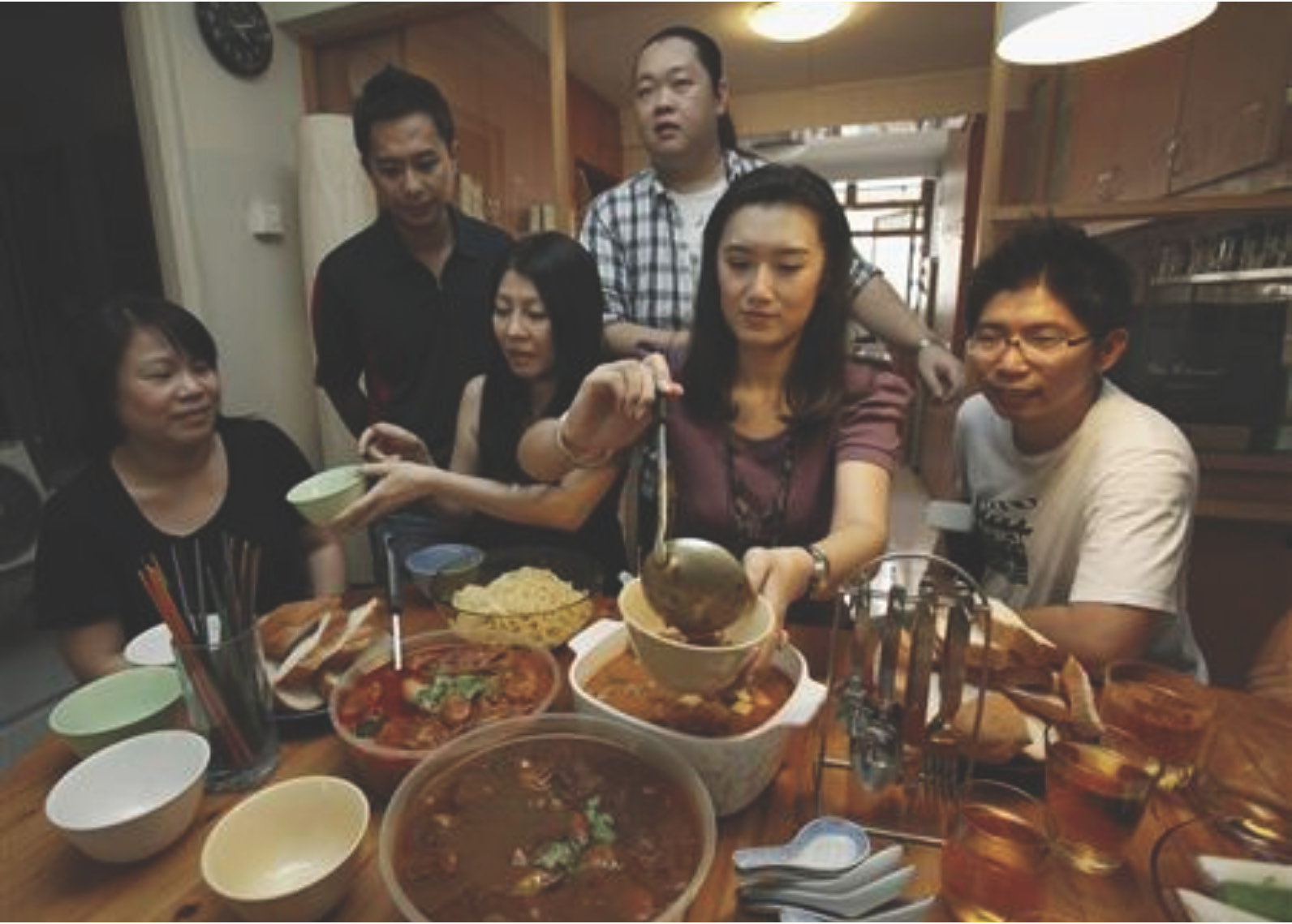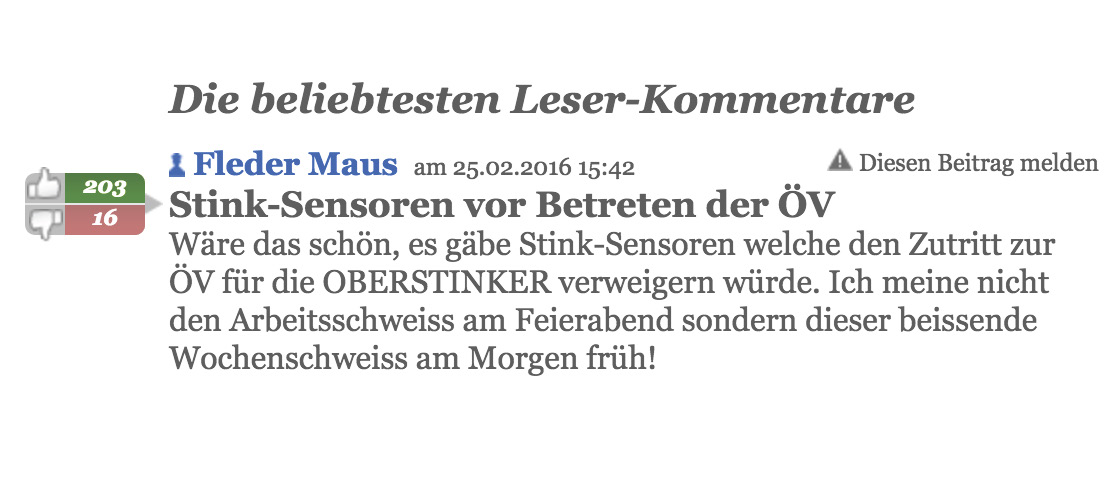In the context of the ongoing controversy on migration politics in Germany, Thomas de Mazière, the Federal Minister of the Interior, joined the group of advocats of a Leitkultur: “Wir sind nicht Burka”.
In his responding essay in the German weekly Freitag, Mladen Gladic, plays with olfactory metaphors:

Accordingly, there is something stinky about de Mazière’s theses (“Leider müffeln sie!”).
Ironic References to Olfactory Metaphors
Moreover, Mladen Gladic begins his 10th point with a rhetorical and openly “smelly question”: How does Germany smell? And he then takes his question to ridicule: “This is really an important question”. In response, he ironically advocates in favor of a “Leitgeruch!” – a common, guiding or leading olfactory note that the Minister of the Interior should enforce. At first sight, this might be a funny point that takes the entire argumentation in favor of a guiding culture to ridicule. But is it a valid point? And what are the broader implications?
Mladen’s response is perfectly in line with the Western repression and cultural denigration of smell. Yet, Mladen Gladic completely ignores what we know by now about the role of the sense of smell from numerous migration contexts:
Anti-Chinese Curry War in Singapore
Have a look at the anti-Chinese curry war in Singapore: Â An immigrant family from China went so far as to file a complaint against their Singaporean-Indian neighbors for the smell of curry emanating from their cooking.

In response 57,600 supporters were incited to back a campaign urging Singaporeans to prepare curry on a designated Sunday, and initiated Singaporeans to share curries from different ethnicities during National Day parties. What is amazing at the story is its specific dynamic leading to more unity among Singaporeans of different ethnicities. Yet, it also demonstrates the potential of conflict of migration related smells.
Historical references
Or think about the long lasting history of racist conceptions of the other’s odors. This pattern goes even back at least to Roman times*!
A long time ago the German philosopher Hubertus Tellenbach noticed: “Atmosphärisch wird das Heimatliche erfasst wie auch das Fremd-Unheimische”. The encounter of strangers is a multisensory experience. In other words: We smell familiarity! Moreover, numerous empirical studies are in line with this philosophical statement.
Racial Conflicts & Smell in North America
So far, Sociology has not paid very much attention to the role of the senses for the development of social forms. In fact, among the classic positions there is only Georg Simmel who reflected on the role of senses in the social domain. His short treatise on the sociology of sense impressions remains a milestone in smell culture studies. Surprisingly, Simmel notices that smell aspects impact on the relationships between ethnic groups:
“The reception of Africans into the higher levels of society in North America seems impossible from the outset because of their bodily atmosphere” (p. 577).
Apparently, in 1908, Simmel even believed in a specific body odor. This certainly sounds outrageous among contemporaries. Yet, with respect to ongoing racial tensions and conflicts in North America the Montreal based scholars Constance Classen, David Howes and Anthony Synnott show how pressing the issue really is:
“No matter how imaginary the racial odour ascribed to blacks by whites might have been, it nonetheless had a profound effect both on how blacks were perceived by others and how they perceived themselves. If you are told often enough that you have a foul odour, you come to believe it. Many blacks, repelled by their olfactory image turned to perfumes and deodorants. Their use of these products could do little to dispel a prejudice which was fundamentally cultural in nature and not physical. Any perfumes used by blacks would simply tend to emphasize their status as »smelly«” (p. 167f.).
Depressing Smellscapes in Refugee Camps
On the other side, there are even remarkable initiatives in refugee camps to address olfactory aspects of the current crisis. Thus, the Syrian refugee Noordin Ibrahim states his mission: “I also needed to change the smell of this place.”
Smell matters!
Browsing through social media one realizes how often smells serves as a point of reference in public discourse on migration politics. Here is an example from a free daily newspaper in Switzerland. The article discusses why strangers smell disgusting:

A guiding smell might not be the solution. But nobody has even advocated this.
Nevertheless, it is pretty apparent that smell matters in migration politics! And the examples demonstrate that it is not even the point whether migrants or anybody else smells or engages in fragrant practices. I am not a natural scientist measuring any “stinky molecules”. The point is about communication and discourse. Smell is common point of reference in public discourse on migration issues. This is sufficient to demonstrate the social and cultural relevance of smell.
To sum up: Mladen Gladic’s ironic use of olfactory metaphors is counter-productive. Instead, what is needed is a careful analysis how smell phenomena are intertwined with migration issues and what could be the role of smell related solutions to alleviate migration issued. This is what I regard as a role for empirical smell culture studies.
Classen, C., Howes, D., & Synnott, A. (1994). Aroma: The Cultural History Smell. London; New York: Routledge.
Simmel, G. (2009). Excursus on the Sociology of Sense Impression. In A. J. Blasi, A. K. Jacobs, & M. J. Kanjirathinkal (eds. & translators), Sociology: inquiries into the construction of social forms (pp. 570–583). Leiden; Boston: Brill.
* Gebke, J. (2014). Himmlische Düfte – Höllischer Gestank: Ãœberlegungen zu einer Kulturgeschichte der Sinne am Beispiel des foetor judaicus im frühneuzeitlichen Spanien. In L. M. Arantes & E. Rieger (Hrsg.), Ethnographien der Sinne: Wahrnehmung und Methode in empirisch-kulturwissenschaftlichen Forschungen (S. 195–212). Bielefeld: transcript.
Image sources:
Facebook event Stanley Wong (2nd L), Florence Leow (3rd L) and Gabriel Yeap (C) eat curry with friends including Liang Meizi (2nd R) from China during a photocall at Leow’s home in Singapore August 21, 2011 http://www.reuters.com/article/us-singapore-curry-idUSTRE77K0TB20110821
